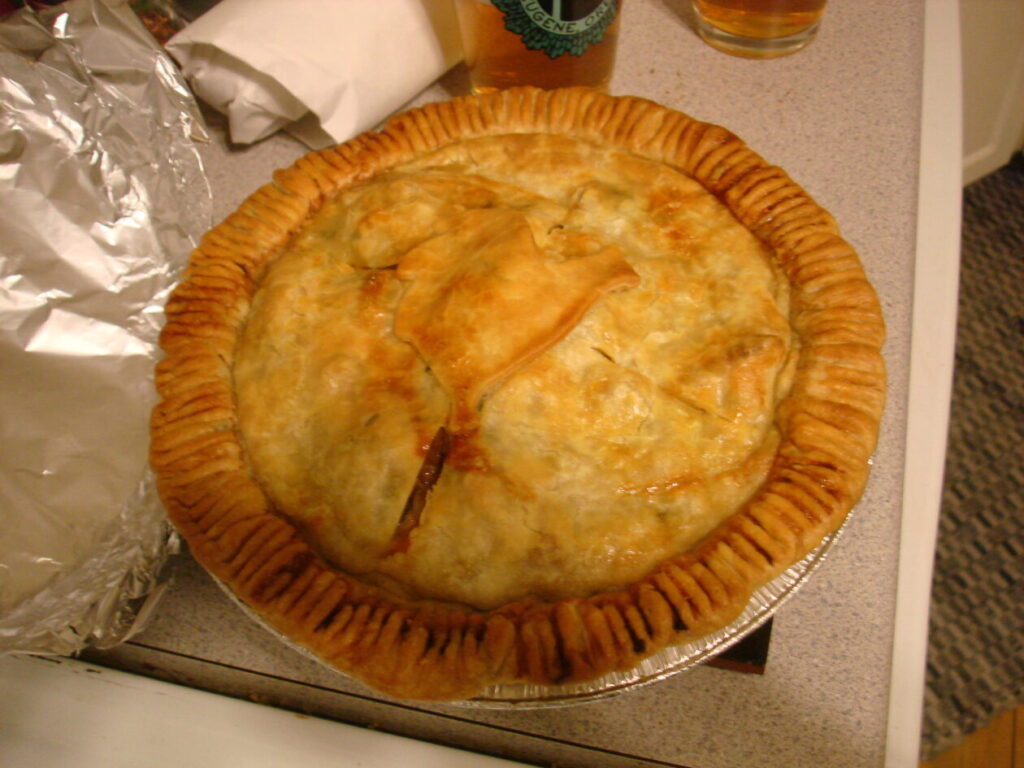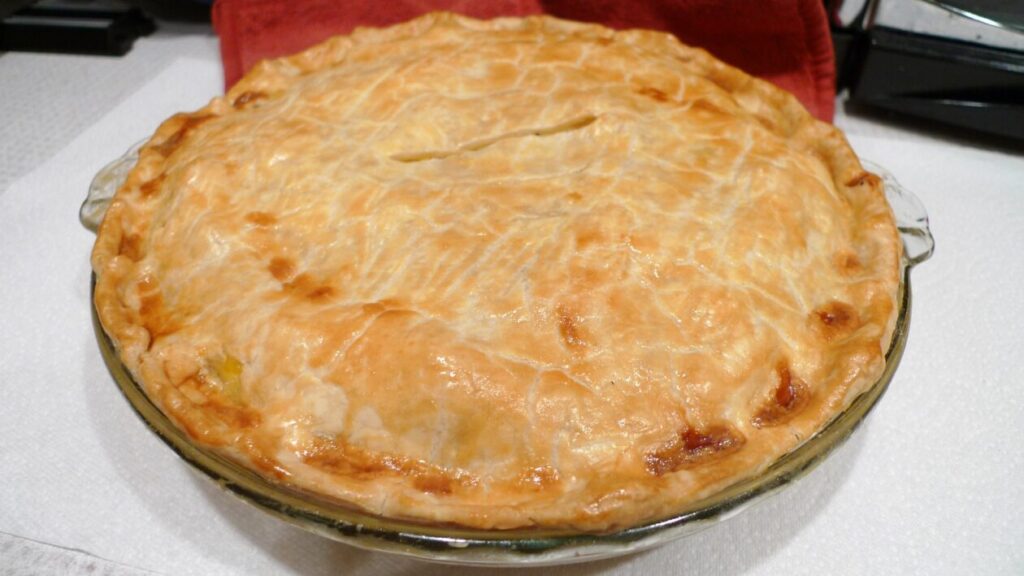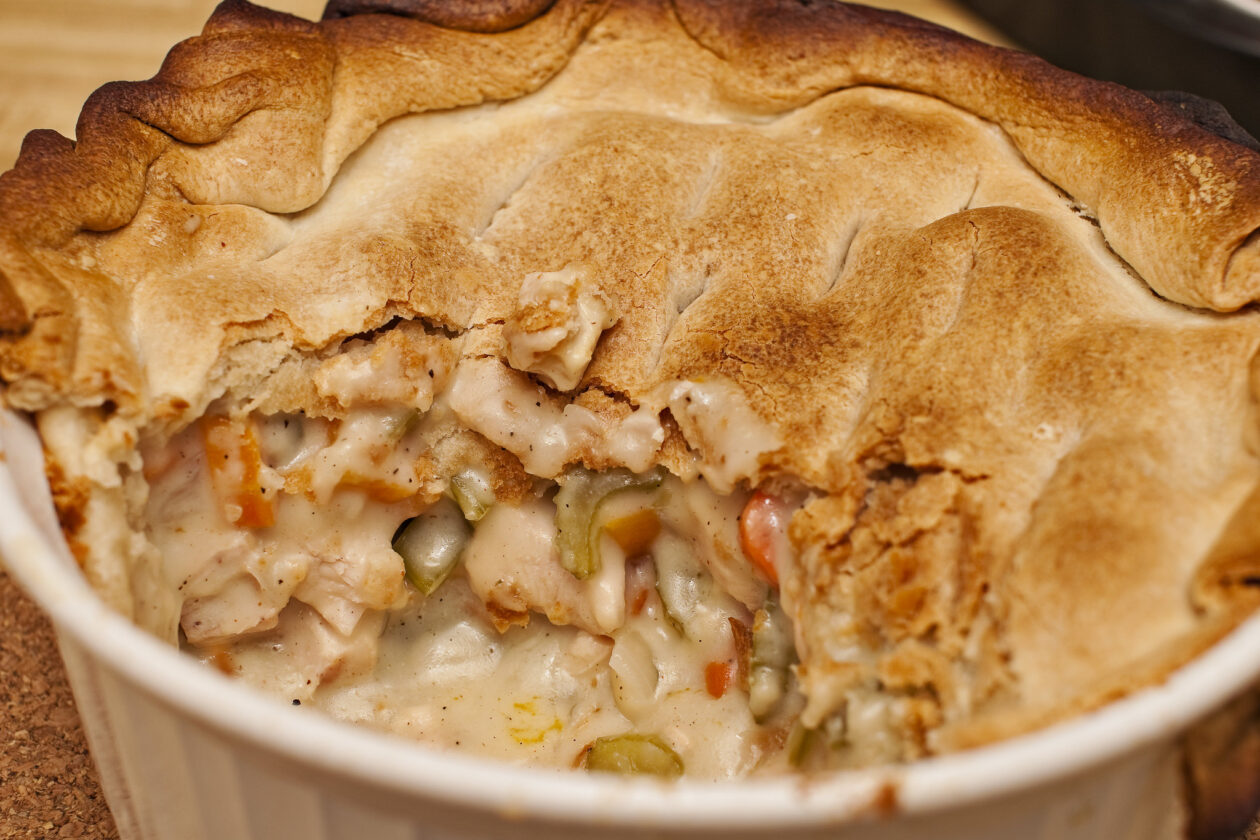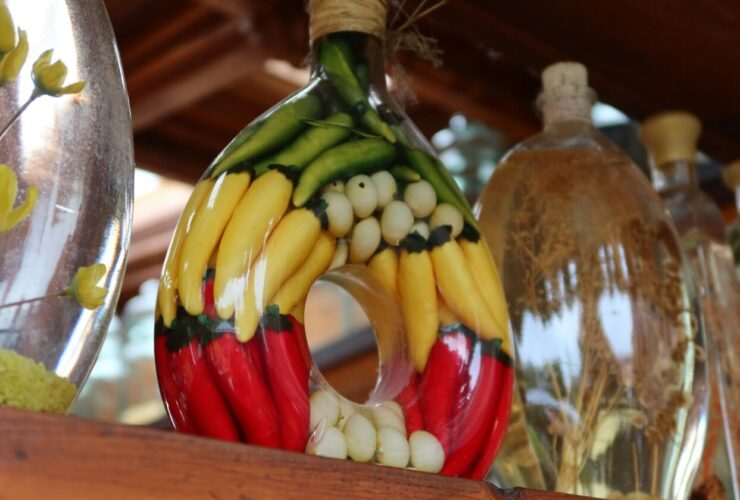Introduction
Chicken pot pie has been a mainstay on dinner tables worldwide for many years. It is a comfort food that is adored for its robust taste and cozy warmth. This meal is the epitome of delicious home-cooked food, from its flaky crust to its flavorful filling. However, amidst the allure of its deliciousness, many health-conscious individuals often find themselves pondering a crucial question: Is chicken pot pie good for weight loss?
Examining chicken pot pie’s nutritional makeup and how it fits into a weight loss plan is critical when discussing this topic. While traditional dishes tend to be more decadent, there are ways to enjoy this classic dish and yet follow a diet. With knowledge of the components, serving sizes, and possible adjustments, people can choose foods that will help them lose weight without compromising flavor or satisfaction.
Throughout this investigation, we’ll discover the reality behind the notion that chicken pot pie and weight loss efforts go hand in hand. We aim to offer clarity and direction for individuals navigating the nexus between gastronomic pleasure and dietary discipline by looking at its calorie count, nutritional value, and effect on satiety. Together, let’s explore the intricacies of chicken pot pie and its significance in leading a more healthful lifestyle.
Nutritional Analysis of Chicken Pot Pie
A thorough analysis of chicken pot pie’s nutritional composition is essential for determining whether it supports weight loss objectives. Let’s break down the main ingredients: chicken, veggies, sauce, and crust.
To begin with, the high-protein chicken gives you the critical amino acids you need for satiety and muscle repair. But since cooking techniques and extra fats can greatly affect the amount of calories, care must be taken. The veggies in chicken pot pie also provide essential vitamins, minerals, and fiber that support digestive system function and general health.
Next, because of its high-fat content, the crust, frequently the dish’s highlight, may be problematic for those watching their weight. Although the pie’s flaky, buttery texture makes it more appealing, you can lessen its calorie content by using lighter substitutes or cutting back on portion sizes.
Regarding the sauce, there are a lot of variations in terms of ingredients and cooking techniques. While broth-based sauces provide a lighter choice, cream-based sauces are typically richer and higher in calories. The dish’s nutritional content can be increased by selecting sauces produced with healthful components and adding herbs and spices for flavor.
According to the USDA’s comprehensive nutritional analysis, a standard serving of chicken pot pie has about 198 calories per 100 grams. While this seems reasonable, it’s important to consider serving sizes and additional portions because overindulging in larger quantities can quickly increase calorie intake.
Nutritional Information (Per 100 grams):
- Calories: 198
- Total Fat: 11 g (16% Daily Value)
- Saturated Fat: 4.2 g (21% DV)
- Trans Fat: 0.1 g
- Cholesterol: 17 mg (5% DV)
- Sodium: 407 mg (16% DV)
- Potassium: 105 mg (3% DV)
- Total Carbohydrate: 19 g (6% DV)
- Dietary Fiber: 1 g (4% DV)
- Granulated Sugar: 2.4 g
- Protein: 4.8 g (9% DV)
Key Points for Weight Loss:
- Calories: Chicken pot pie is relatively high, with 198 calories per 100 grams. It’s essential to be mindful of portion sizes to avoid consuming excess calories, hindering weight loss efforts.
- Total Fat: The entire fat content is 11 grams per 100 grams, contributing to 16% of the daily value. While some fats are necessary for a balanced diet, too much fat intake can lead to weight gain. Opting for lighter crust options or removing excess fat from the recipe can help reduce fat content.
- Saturated Fat: At 4.2 grams per 100 grams, saturated fat constitutes 21% of the daily value. High saturated fat intake increases the risk of heart disease and weight gain. Choosing leaner cuts of chicken and reducing saturated fat in the recipe can be beneficial for weight loss.
- Cholesterol and Sodium: Chicken pot pie contains 17 mg of cholesterol and 407 mg of sodium per 100 grams. Excessive cholesterol and sodium intake can negatively impact heart health and contribute to weight gain. Limiting the intake of high-cholesterol ingredients and opting for low-sodium alternatives can support weight loss goals.
- Protein: Chicken pot pie provides 4.8 grams of protein per 100 grams, contributing 9% of the daily value. Protein is essential for muscle repair and growth, as well as for increasing satiety and reducing overall calorie intake. Including lean protein sources like chicken can support weight loss efforts.
In conclusion, it’s important to be aware of portion sizes and cooking techniques, even though chicken pot pie can be a part of a weight loss plan when consumed in moderation and with thoughtful ingredient selections. People can enjoy the comfort of chicken pot pie without deviating from their dietary objectives by emphasizing lean protein, adding lots of veggies, and choosing lighter crust and sauce options.
Chicken as a Lean Protein Source
Eating a diet high in lean protein is essential for losing weight. In this sense, chicken, a common ingredient in pot pie recipes, has many advantages. Chicken has a good nutritional profile that supports weight loss objectives and is a tasty and adaptable source of protein. Chicken is a great option for people who want to lose weight without sacrificing muscle mass because of its high protein density and comparatively low-fat content compared to red meats.
Among its equivalents, chicken is unique in terms of protein content. Chicken is generally lower in saturated fat than beef or pork, which makes it a heart-healthy choice. Chicken breast, in particular, is well known for having a lot of protein and not a lot of fat, so it’s a great option for people who want to eat more protein without exceeding their calorie consumption.
Including chicken to lose weight does more for you than increase your protein intake. Protein is essential for fostering sensations of satiety and fullness, which can reduce cravings and stop overindulging in food. People who include chicken in their meals may feel fuller and are less likely to snack between meals, which will help them lose weight.
To sum up, because chicken is a lean protein source, it might be a useful tool while trying to lose weight. People can have full meals while pursuing their fitness objectives by utilizing protein-filling properties and selecting lean chicken cuts. Whatever its preparation—grilling, baking, or adding it to cozy recipes like chicken pot pie—chicken is a wholesome and tasty complement to any diet plan.
Vegetables in Chicken Pot Pie

Vegetables are crucial in determining the nutritional value of chicken pot pie. Typically consisting of carrots, peas, onions, and occasionally celery, these veggies have several health advantages beyond improving taste. Their nutritional content is particularly remarkable when it comes to weight loss. For example, carrots are a good source of beta-carotene, a precursor to vitamin A, and support healthy vision and the immune system. Conversely, peas are a great source of fiber and protein, which help maintain regular digestion and fullness.
Vegetables have several weight loss uses when included in chicken pot pies. First, because they are large in volume and low in calories, veggies can add weight to meals without dramatically raising calorie intake. This can be especially helpful for people who want to control their portion sizes and maintain a satisfying feeling while managing their weight. Furthermore, veggie fiber is essential for facilitating digestion and encouraging feelings of fullness. People can enhance their weight loss efforts by incorporating fiber-rich veggies like celery and onions into a chicken pot pie, improving digestive health and promoting fullness.
Additionally, the vitamins and minerals found in vegetables support general health and can help close any nutrient deficiencies in a diet intended to help reduce weight. Onions, for instance, are a great source of antioxidants like quercetin, which may support heart health and have anti-inflammatory qualities. Carrots are also a great source of vitamin C, which is crucial for healthy skin and a strong immune system. When people add a range of veggies to their chicken pot pie, they improve the nutritional value of their food and receive a wide range of vitamins, minerals, and antioxidants vital for good health and weight control.
Crust and Sauce Considerations
Investigating the contribution of the crust and sauce to the nutritional profile of chicken pot pie is crucial when assessing the dish’s appropriateness for weight loss. The buttery, flaky pastry shell that traditionally encases chicken pot pie can add substantial calories and carbohydrates. But people can still enjoy this comfort food and stay on track with their weight loss objectives if they choose their crust carefully. Making crusts with whole wheat or almond flour instead of refined flour can be a healthier choice because these flour types frequently contain more fiber and nutrients. People can cut their chicken pot pie’s calorie and carbohydrate content without compromising flavor or texture by replacing the standard crust with a lighter one.
Furthermore, the nutritional profile of chicken pot pie can be significantly influenced by its type of sauce. Traditional recipes frequently call for a thick, creamy sauce made with heavy cream or butter, which may add to the dish’s high fat and calorie content. But, several lighter sauce options can help people enjoy the rich flavors of chicken pot pie without worrying about gaining weight.
Try using broth-based sauces, Greek yogurt, or low-fat milk instead of heavy cream to lighten the sauce without sacrificing taste. People can customize their chicken pot pie to fit their dietary needs and weight reduction objectives by experimenting with different sauce combinations, which makes it a more wholesome and adaptable choice for those trying to lose weight.
In summary, although chicken pot pie might not seem like a food that would help with weight reduction initially, careful consideration of the ingredients in the crust and sauce can make it a good choice for anyone trying to control their weight. People can still enjoy the comforting pleasures of chicken pot pie without giving up on their weight loss goals by choosing lighter sauces and healthier crusts. Chicken pot pie may be a gratifying and nourishing addition to a balanced diet focused on reaching weight reduction goals with careful component selection and quantity control.
Portion Control and Moderation
Portion control becomes important when losing weight, especially when consuming comfort foods like chicken pot pie. Because of its high fat content, this meal may not usually be linked to weight reduction; nonetheless, moderation is the key to enjoying it without going against your diet plan. People can efficiently reduce their calorie intake while still enjoying the taste of chicken pot pie by adhering to a portion control strategy.
It’s crucial to develop mindful eating practices to handle portion management successfully. This means being aware of hunger signals, eating mindfully, and relishing every mouthful. Instead of overindulging in a large piece, consider portioning out a reasonable serving size of chicken pot pie. To enhance feelings of fullness and satisfaction, serving the pie alongside a substantial serving of steaming vegetables or leafy greens can help bulk the meal without dramatically boosting its calorie level.
Furthermore, it takes planning to include chicken pot pie in a balanced diet. Consider having it as a treat once in a while or including it in a well-rounded meal plan instead of making it the main course of every meal. People can develop a more lasting and well-rounded weight loss strategy by counterbalancing nutrient-dense foods like lean proteins, whole grains, and fresh produce with the indulgence of chicken pot pie.
In summary, chicken pot pie can still be enjoyed in moderation with careful portion management, even though it might not be the best option for people trying to lose weight. People may enjoy this cozy cuisine without sacrificing their health and wellness objectives by eating smaller portions, eating it with wholesome sides, and including it in a balanced diet. Finding a balance between enjoyment and moderation is ultimately more important for weight loss success than deprivation.
Tips and Advice to Make Chicken Pot Pie Weight Loss Friendly

Make thoughtful and calculated adjustments to turn a classic comfort food, like chicken pot pie, into a diet-friendly option. Here are some tips and advice based on the provided articles to help you enjoy this classic dish while supporting your weight loss goals:
1. Choose Lean Protein Sources: Make your chicken pot pie with lean protein sources. Use skinless, boneless chicken breasts instead of dark meat or fatty chicken parts. While still offering vital nutrients, this slim protein choice helps lower the dish’s total calories and fat.
2. Load Up on Veggies: Make sure your chicken pot pie filling contains a range of vegetables. In addition to adding taste and texture, vegetables like carrots, peas, onions, and celery also provide vital vitamins, minerals, and fiber. These nutrients add to your chicken pot pie’s full and pleasant texture by supporting digestive health and promoting satiety.
3. Select Healthier Crust Substitutes: Consider using a healthier crust substitute to make your chicken pot pie lighter. Make crusts with whole wheat or almond flour instead of regular pastry flour. These substitutions lower the dish’s total calorie and carbohydrate content while increasing fiber and minerals.
4. Pay Attention to Portion Sizes: Exercise portion management when serving chicken pot pie. Aim for smaller amounts rather than overindulging, and serve your pie with steamed veggies or a side salad to offer some extra nutrition without going overboard on calories. You may indulge in chicken pot pie without going overboard if you pay attention to portion sizes.
5. Limit Heavy Cream and Butter: Use caution when adding components to your chicken pot pie sauce, such as butter and heavy cream. Although these ingredients enhance flavor and richness, they can add many calories and saturated fat. To get a creamy texture without the extra calories, try using lighter substitutes like Greek yogurt or low-fat milk.
6. Personalize Your Recipe: Adapt your chicken pot pie recipe to your dietary requirements and desired weight reduction by being inventive with it. Try varying the herbs, spices, and seasoning mixtures to add flavor without using too much oil or salt. Add nutritious items like quinoa, spinach, or mushrooms for extra nutrition and texture.
Following these suggestions and guidelines, you can include chicken pot pie in a healthy, balanced diet that supports weight loss. You may enjoy this cozy dish by selecting ingredients carefully, controlling portions, and adjusting the recipe without sacrificing your overall well-being and health objectives. Pay attention to your body’s hunger signals and savor your food with awareness for optimal effects.
Incorporating Chicken Pot Pie into a Balanced Diet
It’s important to evaluate chicken pot pie in the context of a balanced diet when deciding if it helps with weight loss. There are ways to enjoy traditional chicken pot pie as part of a balanced eating plan, even though its high calorie and fat content may not correspond with stringent weight control regimes.
Combining chicken pot pie with more nutritious side dishes boosts its nutritional content and is one way to include it in a weight loss regimen. Consider complementing the meal with various steamed vegetables or a side salad rather than just enjoying a big slice of pie by itself. These ingredients assist in boosting satiety, which keeps you fuller for longer and increases your meal’s fiber and vitamin value.
A balanced approach to eating might also involve the idea of “cheat meals” or decadent pleasures. Even while chicken pot pie might not be the perfect low-calorie food, occasionally having it as part of a balanced diet can help avoid deprived emotions and encourage long-term commitment to good eating practices. The secret is to enjoy the pie’s flavors in moderation and be conscious of portion sizes and the overall balance of your diet.
Consider including chicken pot pie in sample meal plans to show how it might fit into a well-rounded diet for weight loss. For instance, if you’re having chicken pot pie for supper that day, try eating lighter meals like vegetable omelets for breakfast and grilled chicken salads for lunch. This lets you satisfy your daily nutritional requirements while counterbalancing the pie’s greater calorie content.
You can enjoy chicken pot pie as part of a balanced diet that aims to reduce weight by eating it mindfully, in moderation, and with thoughtful meal planning. For long-term success, always pay attention to your body’s hunger and fullness signals, choose portions and meal pairings wisely, and emphasize overall dietary balance.
Is Chicken Pot Pie Good for Weight Loss?
A. Short Answer:
While chicken pot pie can be a comforting and delicious dish, it may not be the best option for those specifically focused on weight loss due to its typically high calorie and fat content. However, with mindful portion control and strategic meal planning, it can still be enjoyed occasionally as part of a balanced diet.
B. In-Depth Analysis:
Many enjoy Chicken pot pie, a classic comfort food, but its nutritional profile sometimes aligns differently with weight loss goals. Traditional recipes often include a buttery crust, creamy sauce, and generous portions of chicken and vegetables, which can contribute to its higher calorie and fat content. However, it’s essential to remember that weight loss is ultimately about achieving a calorie deficit, where you burn more calories than you consume. So, while occasionally indulging in chicken pot pie will only sometimes derail your progress, it’s essential to be mindful of portion sizes and balance it with lighter meals throughout the day.
One way to make chicken pot pie more weight-loss-friendly is by substituting healthier ingredients. For example, using a whole wheat crust or even skipping the crust altogether can significantly reduce the calorie and carbohydrate content of the dish. Additionally, incorporating more vegetables and lean protein, such as skinless chicken breast, can increase the nutritional value and help you feel fuller for longer, reducing the likelihood of overeating.
In summary, while chicken pot pie may not be the most weight-loss-friendly option, it can still be enjoyed in moderation as part of a balanced diet. You can indulge in this comforting dish without compromising your weight loss goals by making mindful ingredient choices, practicing portion control, and balancing it with lighter meals and plenty of vegetables. Remember that sustainability and consistency are key to successful weight management, so focus on making long-term, sustainable changes to your eating habits rather than strict deprivation.
FAQs About Chicken Pot Pie and Weight Loss
1. Are pot pies good for weight loss?
Pot pies, including chicken pot pie, are typically high in calories and fat, which may not align with weight loss goals when consumed frequently or in large portions. However, with mindful ingredient choices and portion control, they can still be enjoyed occasionally as part of a balanced diet.
2. Can I eat chicken pie on a diet?
Yes, you can include chicken pie in your diet. Still, it’s essential to be mindful of portion sizes and choose healthier variations with lean protein, plenty of vegetables, and lighter crust options to support your weight loss efforts.
3. Is chicken pot pie unhealthy?
Chicken pot pie can be unhealthy with high-fat ingredients like buttery crusts and heavy cream sauces. However, healthier versions can be created using whole wheat crusts, lean protein, and vegetables.
4. Is chicken pot pie good for gaining weight?
Due to its high calorie and fat content, consuming chicken pot pie regularly without considering portion sizes or healthier ingredients may contribute to weight gain for some individuals.
5. Is chicken pot pie high in calories?
Chicken pot pie is typically high in calories, especially if it contains a buttery crust and creamy sauce. However, opting for lighter crust options and loading up on vegetables can help reduce its calorie content.
6. How much fat is in a chicken pie?
A chicken pie’s fat can vary depending on the recipe and ingredients used. Traditional chicken pot pies may contain significant fat from buttery crusts and creamy sauces.
7. Is chicken pie high in protein?
Chicken pie can be a good source of protein, especially if it contains generous portions of chicken breast. However, the protein content may vary depending on the recipe and ingredients.
8. Which pie has more calories?
Pies with richer fillings and buttery crusts, such as chicken pot pie or steak and ale pie, tend to have higher calorie content than lighter fruit pies like apple or cherry pie.
9. Why are pies so high in calories?
Pies are often high in calories due to their rich fillings, including meats, cheeses, creamy sauces, and buttery crusts made from flour and butter.
10. How many calories in a 200g chicken pie?
The number of calories in a 200g chicken pie can vary depending on the recipe and ingredients. However, traditional chicken pot pies can range from 300 to 600 calories or more per serving.
11. Does chicken pie have carbs?
Chicken pie typically contains carbohydrates from ingredients like flour in the crust and starchy vegetables like potatoes. However, choosing whole wheat crusts and adding more vegetables can provide healthier carbohydrates.
12. Does pie have calories?
Yes, pies contain calories from flour, sugar, butter, and fillings. The calorie content can vary depending on the type of pie and its ingredients.
13. What nutrients are in a chicken pie?
Chicken pie can provide essential nutrients such as protein, vitamins, and minerals, depending on the ingredients used. Lean protein from chicken, vitamins from vegetables, and minerals from whole wheat crusts contribute to its nutritional value.
14. Is homemade chicken pot pie healthy?
Homemade chicken pot pie can be made healthier using lean protein, whole wheat crusts, and plenty of vegetables. Controlling portion sizes and avoiding excessive use of high-fat ingredients can also enhance its healthfulness.
15. Healthy chicken pot pie, no crust?
A crustless chicken pot pie can be a lighter alternative, reducing the calorie and carbohydrate content. You can create a healthier version of this classic dish by focusing on the flavorful filling and loading it with vegetables and lean protein.
16. Healthy chicken pot pie recipe Weight Watchers?
For a Weight Watchers-friendly chicken pot pie recipe, consider using lean protein, plenty of zero-point vegetables, and lighter crust options. This can help keep the dish lower in calories and points while still being satisfying and delicious.
17. Is chicken pot pie good?
Chicken pot pie can be a delicious and comforting dish enjoyed by many. However, its healthfulness depends on the ingredients used and portion sizes consumed. Making healthier choices can enhance its nutritional value.
Conclusion
In conclusion, several variables affect whether or not chicken pot pie is beneficial for weight loss. Even though classic chicken pot pies could be heavy in fat and calories, there are methods to modify them for better weight loss. You may enjoy chicken pot pie as part of a healthy diet by using lighter crust options, adding lots of veggies, and regulating portion sizes.
When examining the benefits of chicken pot pie for weight reduction, it is imperative to stress the need for portion management and mindful eating. Paying attention to components and portion proportions ensures that chicken pot pie fits your overall dietary objectives and avoids consuming excessive calories.
The secret to effective weight loss is ultimately figuring out what balance is right for you. While occasionally treating yourself to chicken pot pie can be part of a diverse diet, focusing on overall nutritional balance and making decisions to help you lose weight is important. You can still achieve your health and wellness objectives while enjoying your favorite foods by adopting modest lifestyle changes and exercising sensibly.
Reference
Gupta, A. (2023, July 18). Ten lean protein foods for weight loss to help you drop extra kilos. Healthshots; Healthshots. https://www.healthshots.com/healthy-eating/nutrition/lean-protein-foods-for-weight-loss/
Vitamin A. (2012, September 18). The Nutrition Source. https://www.hsph.harvard.edu/nutritionsource/vitamin-a/
FoodData Central. (2024). Usda.gov. https://fdc.nal.usda.gov/fdc-app.html#/food-details/173331/nutrients
Was this helpful?

Joseph Emb, RDN
Founder of StyleVitally.com | Registered Dietitian & Wellness Advocate
What I Cover:
I’m passionate about connecting nutrition science and everyday wellness to help people live healthier, more vibrant lives. I write about evidence-based nutrition, mindful eating, sustainable lifestyles, and holistic well-being at StyleVitally.com.
My Background:
The University of Texas in Austin, where I earned my Dietetics diploma, laid the groundwork for my nutrition and health career. My training and hands-on experience taught me the science and art of using nutrition to enhance health and well-being.
Professional Journey:
I’m an RDN with lots of experience. I’ve helped people seeking tailored nutritional recommendations in clinical settings and community outreach programs. My constant learning and professional development ensure that my recommendations are always based on the latest evidence.
Ethical Commitment:
My practice prioritizes integrity. My content is transparent and objective, following the most significant ethical standards. I can give my audience unbiased advice because I’m not affiliated with food businesses or industry associations. I want to help people make informed health decisions that match their values and ambitions.
Join Me on the Wellness Journey:
Join me on the path to vitality and well-being, whether facing nutritional issues, seeking sustainable lifestyle changes, or simply wanting a better, happier you. We’ll discover how diet, mindfulness, and holistic well-being can maximize your potential.










Leave a Reply
View Comments